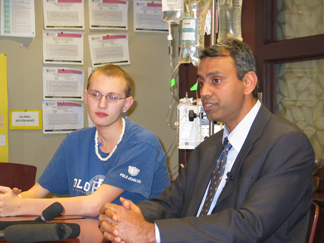 |
Justin Cornish and Mohammed Quader, M.D., talk to the media days before the teen’s heart transplant. |
Cornish and his mother received word in the early morning hours of Friday, Dec. 30 that a donor heart was available. The teenager seemed to have a sixth sense that his lifesaving surgery was on the horizon. “The day before he kept saying, ‘Mom, I know I’m going to get a heart. My heart’s coming tomorrow,’ ” said his mother, Vickie Cornish. “When we got the call, I couldn’t believe it. It was just amazing.”
Prior to surgery, Cornish’s condition had deteriorated significantly. However, less than 24 hours after the transplant, he was already showing signs of improvement.
“Justin is really adjusting well to his new heart and the new heart is adjusting well to Justin’s body,” said Mohammed Quader, M.D., lead transplant surgeon at The Nebraska Medical Center and assistant professor of cardio-thoracic surgery at UNMC. “There’s a clear difference in his overall attitude and condition. When I walked into his room Saturday morning, the first thing Justin did was give me a double thumbs up sign.”
|
|
The transplant was Cornish’s final hope. He suffers from an extremely rare form of muscular dystrophy called Danon’s disease. It attacked his heart, leaving him with very little time and limited treatment options. The same condition killed two of his brothers, Richard, 18, in 2002, and Everett, 13, in 2004.
“Justin’s really glad that he’s alive,” his mother said. “He said he’s going to live a good life for himself and for his brothers who didn’t have a chance to do that.”
“He was so excited and kept on thanking me and the transplant team for doing his surgery,” Dr. Quader said. “I feel a profound sense of accomplishment that we were able to help this family.”
Vickie Cornish also is quick to acknowledge the sacrifice that gave her son a second chance. “I spend a lot of time praying for the family who made the decision to donate the organ. I know what they’re going through with the loss of a loved one,” she said. “They were generous to help other people like my son.”
Vickie Cornish recently renewed her driver’s license and described herself as being in tears as she indicated that she wanted to be an organ donor. She hopes her family’s emotional struggle will pave the way for change on two fronts.
“I urge people to become organ donors,” she said. “I’m also working toward increasing awareness for muscular dystrophy. I’d like to see a cure so this doesn’t happen to other people. It’s been too late for my children, but I hope ongoing genetic research and other advances could help my grandchildren.”
Two of Cornish’s other siblings, an older sister and a younger brother, have not shown signs of Danon’s disease. Vickie Cornish, however, experienced adult onset of the condition and now uses a pacemaker and defibrillator.
Cornish’s transplant marks the fifth heart transplant in just three months at The Nebraska Medical Center.